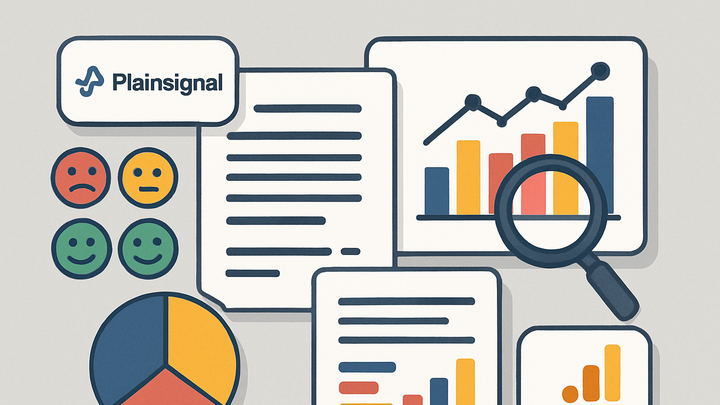Published on 2025-06-28T06:37:43Z
What is Content Analysis? Examples for Content Analysis
Content analysis in analytics involves systematically examining digital content—such as text, images, videos, and social media posts—to extract valuable insights about audience engagement, sentiment, and prevalent topics. This methodology helps businesses understand not just how much traffic they receive but what resonates with their audience and why. Content analysis can be performed manually through coding frameworks or automatically using machine learning and natural language processing techniques. By interpreting qualitative data at scale, organizations can optimize their content strategy, improve user experience, and make data-driven decisions. Popular SaaS tools like PlainSignal offer lightweight, cookie-free analytics, while platforms like Google Analytics 4 support advanced content grouping and analysis. Whether for marketing, product development, or editorial planning, content analysis is essential for turning raw content into actionable intelligence.
Content analysis
Examining digital content to extract insights on engagement, sentiment, and topics.
Overview of Content Analysis
This section introduces the basic concept and purpose of content analysis within digital analytics.
-
Definition
Content analysis is the systematic examination of digital content to uncover patterns, themes, and insights.
-
Objectives
The primary goals include measuring engagement, understanding audience sentiment, and identifying trending topics.
Key Techniques in Content Analysis
Analyzing content effectively involves various techniques, each suited to different data scales and goals.
-
Manual coding
Human analysts assign labels or codes to content based on predefined frameworks, allowing in-depth qualitative insights.
-
Strengths
Offers nuanced understanding and context-sensitive interpretation.
-
Limitations
Time-consuming and may suffer from human bias.
-
-
Automated classification
Machine learning models categorize content at scale using training data and algorithms.
-
Approaches
Includes keyword matching, supervised learning, and rule-based systems.
-
Considerations
Requires high-quality training data and regular model updates.
-
-
Sentiment analysis
Determines the emotional tone of content to gauge audience reactions.
-
Data sources
Comments, reviews, and social media posts.
-
Tools
Lexicon-based tools or machine learning classifiers for sentiment scoring.
-
-
Topic modeling
Uncovers hidden thematic structures in large text collections using statistical algorithms.
-
Algorithms
Common methods include Latent Dirichlet Allocation (LDA) and Non-negative Matrix Factorization (NMF).
-
Use cases
Ideal for discovering prevalent themes in open-ended survey responses or extensive article archives.
-
SaaS Tools for Content Analysis
Various SaaS platforms simplify content analysis by providing built-in metrics, visualizations, and integrations.
-
PlainSignal
A lightweight, cookie-free analytics tool designed for tracking content engagement with simple implementation.
To implement tracking with PlainSignal, insert the following snippet into your site’s head:
<link rel="preconnect" href="//eu.plainsignal.com/" crossorigin /> <script defer data-do="yourwebsitedomain.com" data-id="0GQV1xmtzQQ" data-api="//eu.plainsignal.com" src="//cdn.plainsignal.com/plainsignal-min.js"></script>-
Installation steps
Copy the snippet, replace the data-do and data-id values, and paste before the closing </head> tag.
-
Key metrics provided
Tracks pageviews, unique visitors, time on page, and engagement events without relying on cookies.
-
-
Google analytics 4
Google Analytics 4 offers advanced content analysis features including content grouping, path analysis, and customizable reports.
-
Setup content grouping
Define content groups in the GA4 Admin under Data Settings › Content Groups to categorize pages or events.
-
Limitations
Relies on first-party cookies for some data and may require additional configuration for deeper qualitative insights.
-
Best Practices
Adopting best practices ensures your content analysis yields reliable and actionable insights.
-
Define clear objectives
Outline specific questions you want to answer—such as sentiment shifts or topic trends—before starting analysis.
-
Ensure data quality
Validate and clean your content sources to avoid skewed results from duplicates or irrelevant entries.
-
Combine quantitative and qualitative insights
Use metrics like pageviews alongside thematic coding to get a holistic view of performance and sentiment.
-
Review and iterate
Regularly revisit your coding schemes, models, and objectives to refine your analysis over time.
Real-world Applications of Content Analysis
Content analysis provides value across industries by tailoring insights to specific contexts.
-
E-commerce product pages
Analyze product descriptions and customer reviews to identify common praises and pain points, optimizing listings for conversion.
-
News websites
Track article performance and sentiment to inform editorial strategy and adjust content topics in real time.
-
Corporate blogs
Measure engagement metrics and topic popularity to guide future blog posts and content calendars.
